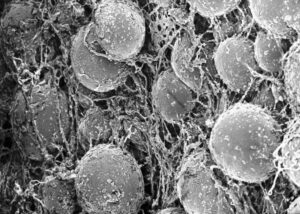Introduction
Weak protein-protein interactions are a common phenomenon inside cells. Besides being well known, it has a crucial impact on cellular homeostasis and metabolism when involving key regulators. As examples, AMPK, PDK1, TOR, or PGK are master regulators of cellular homeostasis as they all control key metabolic pathways. In this 2017 paper, Sukenic, Ren, and Gruebele studied the impact of cell-volume on these protein aggregates looking at the specific case of GAPDH interaction with PGK. To achieve fine control of the volume, the authors built a smart set-up to control the osmotic power of the media supply (see a comparison of perfusion methods here). Indeed, they realized a perfusion set-up allowing to switch between different media, all varying in osmotic pressure.
By further characterizing the APDH-PGK complex association, Sukenic and co-authors suggested that cellular volume changes (as occurring when cells enter into mitosis), can be a regulatory mechanism controlling protein complex concentrations.
How to culture vascularized & immunocompetent 3D models in a standard Multiwell
Summary
Weakly bound protein complexes to play a crucial role in metabolic, regulatory, and signaling pathways, due in part to the high tunability of their bound and unbound populations. This tunability makes weak binding (micromolar to millimolar dissociation constants) difficult to quantify under biologically relevant conditions. Here, we use rapid perturbation of cell volume to modulate the concentration of weakly bound protein complexes, allowing us to detect their dissociation constant and stoichiometry directly inside the cell. We control cell volume by modulating media osmotic pressure and observe the resulting complex association and dissociation by FRET microscopy. We quantitatively examine the interaction between GAPDH and PGK, two sequential enzymes in the glycolysis catalytic cycle. GAPDH and PGK have been shown to interact weakly, but the interaction has not been quantified in vivo. A quantitative model fits our experimental results with log Kd = −9.7 ± 0.3 and a 2:1 prevalent stoichiometry of the GAPDH: PGK complex. Cellular volume perturbation is a widely applicable tool to detect transient protein interactions and other biomolecular interactions in situ. Our results also suggest that cells could use volume change (e.g., as occurs upon entry to mitosis) to regulate function by altering biomolecular complex concentrations..
References
FAQ
Weak protein-protein interactions are a common phenomenon found inside cells. These interactions are studied because they have a very important effect on cellular homeostasis and metabolism. This effect is particularly noted when main regulators are involved in the interactions. Examples of these regulators include AMPK, PDK1, TOR, or PGK. These specific examples are recognized as master regulators of cellular homeostasis, as they all control central metabolic pathways. Weakly bound protein complexes are understood to play a main part in metabolic, regulatory, and signaling pathways. This importance is partly due to the high tunability of their bound and unbound populations, which makes their study relevant. However, this same tunability makes weak binding (defined by micromolar to millimolar dissociation constants) difficult to quantify under biologically relevant conditions.
The interaction between GAPDH and PGK was examined by researchers (Sukenic, Ren, and Gruebele) in a 2017 paper. These two substances are sequential enzymes in the glycolysis catalytic cycle. Although they were known to interact weakly, the interaction had not been quantified in vivo. To study them, a method involving the rapid perturbation of cell volume was used. This method modulates the concentration of the weakly bound protein complexes. Cell volume was controlled by modulating the osmotic pressure of the media. A perfusion set-up was built by the authors, allowing them to switch between different media that varied in osmotic pressure. The resulting complex association and dissociation were then observed using FRET microscopy. This approach allows the detection of the dissociation constant and stoichiometry directly inside the cell.
The study focused on the specific case of GAPDH interaction with PGK. The experimental results were fitted to a quantitative model. This model produced specific findings for the complex. The dissociation constant was determined, with a resulting log Kd \= −9.7 ± 0.3. This quantification of the interaction had not previously been achieved in vivo. Furthermore, a prevalent stoichiometry of 2:1 for the GAPDH:PGK complex was identified by the model. By further characterizing the association of this complex, the authors were able to form suggestions about cellular regulation. These results demonstrate how the experimental method (cellular volume perturbation) can be used to obtain precise measurements for transient interactions in situ.
The research provides two main suggestions. First, the method of cellular volume perturbation is presented as a widely applicable tool. It can be used to detect transient protein interactions. It may also be used for other biomolecular interactions in situ. Second, a potential regulatory mechanism for cells is suggested. The authors proposed that cellular volume changes can be a regulatory mechanism that controls protein complex concentrations. An example of such a volume change occurs when cells enter into mitosis. The results suggest that cells could use this type of volume change to regulate their function. This regulation would be achieved by altering the concentrations of biomolecular complexes.





